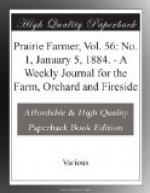Fall Varieties—First, Snow; second, Standard; third, Maiden Blush; fourth, Colvert; fifth, Baker Sweet; sixth, Pound Sweet; seventh, Fall Romanite.
Winter Varieties—First, Minkler; second, Rawles’ Genet; third, Willow Twig; fourth, Little Romanite; fifth, English Russet; sixth, Ben Davis; seventh, Michael Henry Pippin; eighth, Jonathan; ninth, Gravenstein; tenth, Rome Beauty.
In varieties in pears he gave the Howell and the Bartlett. In grapes he recommended the Martha in white grapes.
GRAPES.
Mr. E.A. Riehl, of Alton, read a very exhaustive and complete report on grapes and grape culture, including the so-called grape rot. The suggested remedies were bagging and training vines up on elevated wires, so the sun and air could get freely to the fruit. This point was combated by Dr. Shroeder. Grapes ripen best in the shade. Another gentleman suggested that with the wire system as suggested by Mr. Riehl, the grapes are shaded by the foliage in all the hottest part of the day.
INSECTS.
Prof. Forbes gave a learned and scientific dissertation on contagious diseases of insects, and a number of germinal diseases, and experimental and successful attempts to kill them. The Professor showed that nausea is contagious and may be transferred by diseased worms, and that therefore the spread of disease in worms would considerably lessen the danger to plants and fruits from their inroads. These facts, said the Professor, give us reason to hope that we have discovered another means of defense from destructive insects.
Mr. Earle will try pyrethrum next season for the tarnished bug. Prof. Budd gave a brief sketch of latest methods of killing off noxious insects as followed by J.N. Dixon, of the State of Iowa, one of the greatest fruit farmers in that State or in the Northwest. He destroys the insect by sprinkling the trees with water diluted with arsenic, using one pound of white arsenic to 200 gallons of water. This has proven a great success and is not at all expensive. Some members objected to the use of arsenic on account of its poisonous properties. London-purple or Paris-green were recommended by some. Some members did not like to have hogs running in their orchards; others found them a benefit if but few were permitted. They did a good work. If the orchard is overstocked with them they do harm. They root about the trees and rub against them. It is not an uncommon thing for them to kill the trees in the course of a couple of years.




